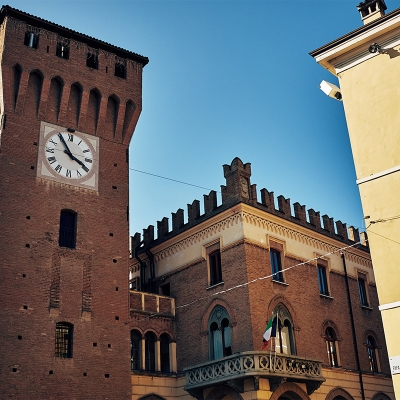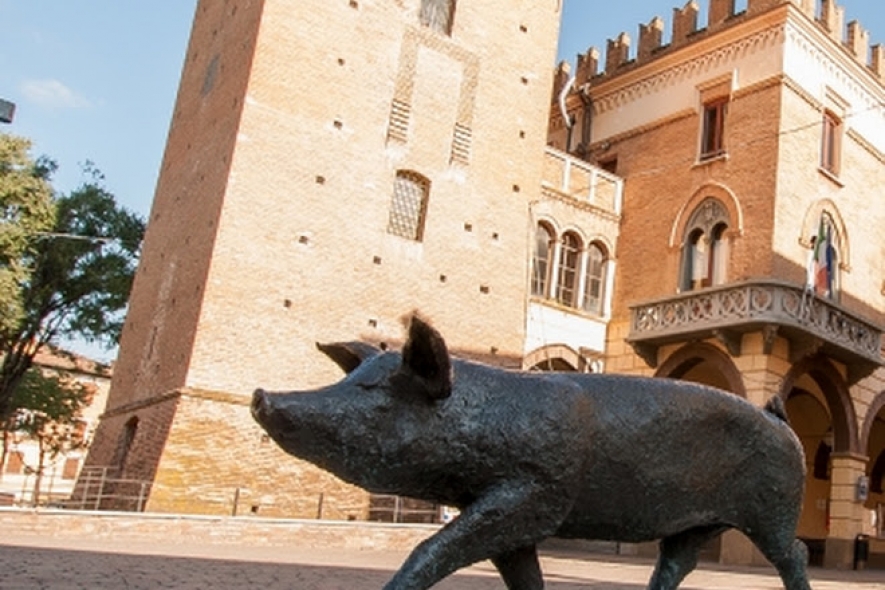
The Torrione and walls
The civic tower of Castelnuovo Rangone, called Torrione, dates to the 15th century and is the main monument of the town. It is a testimony to the ancient castle built here in the tenth century.

If you don't throw anything away from a pig (Italian saying), Castelnuovo Rangone has decided not to miss out on anything: discover the monument to the pig, the festival of the world's largest zampone (stuffed pig's trotter) and the Delicatessen Museum.
It is impossible to talk about the Modena area without mentioning the pig. From breeding to catering, the area's economy is based on pork. It is such an important element that it deserves a monument in the centre of Castelnuovo Rangone. Right there, where animals on their way to the slaughterhouse used to pass by, there is now a statue symbolising an important link.
The link of the pig in particular with Terre di Castelli dates back to ancient times and to culinary traditions. Just think of the municipal statutes that already mentioned butchers and charcuterie merchants (so-called salaroli and lardaroli) in the 14th century.
At the time, the pig was fattened up for lard and to make sausages, but it was not until the post-war period that meat consumption became common as a consequence of abundance. It was boiled pork sausages that were the first products to make our province famous, foods such as cotechino (large pork sausage requiring slow cooking) or zampone. With time also came minced meat, roasts, offal of butchered animals in all its versions, and ciccioli frolli (pork crackling), residues of meat and cartilage from the rendering of pork fat.

According to tradition, the first zampone was invented in Mirandola in 1511. At that time, the city was besieged by Pope Julius II Della Rovere's army and the local population, now reduced to starvation, was faced with the decision of what to do with all their pigs. Not slaughtering them would have meant giving them to the enemy, but then how to preserve them?
The idea came from one of Count Pico della Mirandola's cooks: slaughter the animals and stuff the leanest meat into a casing formed from the skin of its trotters. This was a preservation method to postpone the cooking of the food until a later time.
It was not until the end of the 18th century that zampone and cotechino replaced the yellow sausage that made Modena famous during the Renaissance. The new local products also began to spread to the surrounding areas, encouraging the opening of the first delicatessens.
After five centuries, the territory's two most famous sausages and fathers of all sausages containing rind are still prepared according to the original recipe. Mince, pepper, nutmeg, cinnamon, cloves and wine, stuffed into the front trotter for Zampone Modena IGP, stuffed into casings for Cotechino Modena IGP.
Chosen as the kings of the holiday season as a result of the peasant tradition of sacrificing the pig for Saint Lucy, zampone and cotechino are two highly versatile products that fit easily into menus to be enjoyed all year round. While in Renaissance times it was accompanied by zabaglione, today it can be served with lentils, stewed beans, mashed potatoes or with cheese.

While it may be difficult to find a precise date for the origin of prosciutto, it is believed that pig breeding has been present in the Panaro River area since very ancient times. As early as the Bronze Age, animals were used for meat production in parallel with the discovery of the use of salt for their preservation and curing.
Salted pork constituted the main food supply of peasant families and in 1547 lardaroli and sausage makers formed an autonomous guild, making their art recognised and becoming a real point of reference.
Prosciutto soon became a typical fine product favoured by Renaissance courts: Borso d'Este and Rinaldo d'Este were two great consumers, going so far as to distinguish 'mountain' from 'local' prosciutto. Moreover, since nothing was thrown away, the uneaten meat was reused in other recipes such as tortellini.
The history of Modena Prosciutto goes all the way back to 1969, when the Consortium was established on a voluntary basis, obtaining the coveted European Protected Designation of Origin.
More sweet than salty in flavour, bright red in colour and with an intense aroma, prosciutto is ideal accompanied by tigelle (flatbread with filling), gnocco fritto (a sort of fried dumpling) and a good glass of Lambrusco.

With such a deep-rooted pork culture and a monument dedicated to the pig, Castelnuovo Rangone could not miss the festival dedicated to the world's largest zampone.
Superzampone is the event organised every year by the Ordine dei Maestri Salumieri (Association of Master Sausage Artisans) together with the Municipality. The event takes place together with various side events involving schools and the world of volunteering.
Born in 1989 from a playful idea that saw a group of people from Castelnuovo create a two-metre-long papier-mâché zampone, the idea was taken up by the 'king of zampone' Sante Bortolamasi who, together with some friends, decided to make a real one.
The first record came in 1991 and since then Superzampone has never left the Guinness Book of Records: 450 kg was reached in 2000, while the last record of 1,038 kg dates back to 2014. Since then, it has been decided to reduce the quantity in preference to the quality of the result, while still maintaining the joyful carnival atmosphere typical of the local tradition.
The three-metre long Superzampone is cooked in a huge zamponiera (steel pot) for about three days. Once ready, it is brought on stage, kicking off the festival where it is served free of charge to the population. Sports and entertainment personalities are involved: Luciano Pavarotti, Piero Ferrari, Loris Capirossi, Max Biaggi, Luca Toni, Nino Benvenuti, Sandra Milo, Mirella Freni, Giovanni Rana and Massimo Bottura to name but a few.

The first cured meat museum in Italy is the MuSa (Museo della Salumeria), located in Castelnuovo Rangone and born as a direct consequence of Villani Salumi's art of cured meat production.
Villani SpA is a family business that was founded in 1886 by Costante Villani and Ernesta Cavazzuti. After a period of marketing fresh meat, they began to focus on pork slaughtering, curing and cured meat production. The company was so cutting edge that it was already exporting to New York in the 1930s.
After a trip to the United States, their son Giuseppe returned with new ideas and new tools to innovate the production process. He introduced trolleys for cured meats and travelled around Italy to master the curing techniques of other regions.
The MuSa is a space for communication, education and dissemination. Through a multi-sensory and multimedia itinerary, visitors can discover the history and processing techniques of an entire gastronomic heritage.
On the occasion of Expo 2015, the museum was chosen by the Ferrari Museums as a stop on the Discover Ferrari & Pavarotti Land package.
Inaugurated in 1997, the monument was created by Dutch artist Kee Sansen and represents a life-size pig sculpted in the act of walking through the town of Castelnuovo Rangone. It is located between the Tower and the Church of San Celestino and represents the animal-symbol of Castelnuovo's economy. The monument was donated by the Ente Esportazioni Carni Olandese (Dutch Meat Export Board).
Castelnuovo Rangone's civic tower dates back to the 15th century and is the town's main monument. It was built as a guard post for the walls that surrounded the castle built here in the 10th century. The walls, which date back to the 13th century, were rediscovered only recently and are among the most important in the province.
THE CHARCUTERIE MUSEUM
Born from an idea of the Villani family, the ‘Museo della Salumeria’ (MuSa) is the first in Italy dedicated to the art of cured meat. It is housed in 200 square metres of exhibition space with images, videos, texts and ancient machinery. It is possible to have a tasting at the end of the visit.